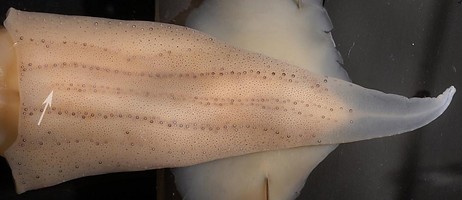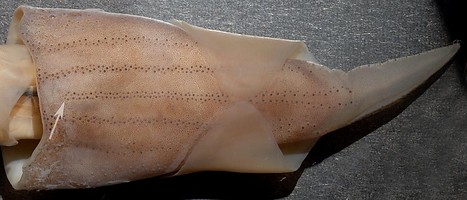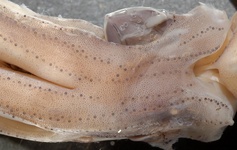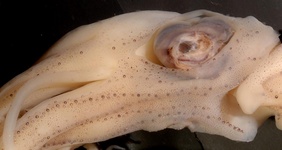Enoploteuthis magnoceani
Kotaro Tsuchiya and Richard E. YoungIntroduction
Enoploteuthis magnoceani, has never been fully described and we know less about it than most species of the genus.
Characteristics
- Arms: Hectocotylus
- Hectocotylus with a large truncate membranous flap on the ventral edge.
- Modified portion with armature.
- Tentacle
- Tentacle short, narrow.
- Carpal cluster elongate.
- Two rows of subequal-sized hooks on manus.
- Two rows of suckers on dactylus.
- Head
- Beaks: Descriptions can be found here: Lower beak; upper beak.
- Beaks: Descriptions can be found here: Lower beak; upper beak.
- Integumental Photophores
- Ventral mantle with five longitudinal but weakly oblique stripes of integumental organs; median stripe actually two, closely adjacent, longitudinal rows that converge anteriorly then join and terminate prior to reaching mantle margin. ventralmost pair of stripes is obscure and fused to lateral rows; narrow photophore-less strip at the midline.
Figure. Ventral views of mantle photophores of E. magnoceani, immature females. Top - 45 mm ML. Bottom - 70 mm ML. Arrows point to the anterior end of the median stripes. Photographs of preserved squid by R. Young.
- Ventral head with six longitudinal stripes of integumental organs (does not include eyelid photophores). Lateral-most stripe broken at window in integument. Photophores absent between the latter and eyelid photophores.
- Ventral side of arm III with a row of organs along almost entire arm.
- Ventral mantle with five longitudinal but weakly oblique stripes of integumental organs; median stripe actually two, closely adjacent, longitudinal rows that converge anteriorly then join and terminate prior to reaching mantle margin. ventralmost pair of stripes is obscure and fused to lateral rows; narrow photophore-less strip at the midline.
Nomenclaure
Nesis (1982/87) considered the Pacific form of E. leptura to be a separate subspecies E. leptura magnoceani due to the photophore arrangement of anterior ventral mantle. Although the description of E. magnoceani is incomplete, the evidence is adequate to consider it as a valid species.
Distribution
Geographical distribution
Tropical western and central Pacific Ocean and Australo-Asiatic seas (Nesis, 1982/87) also in the western North Pacific.
References
Nesis, K. N. 1982. Abridged key to the cephalopod mollusks of the world's ocean. 385+ii pp. Light and Food Industry Publishing House, Moscow. (In Russian.). Translated into English by B. S. Levitov, ed. by L. A. Burgess (1987), Cephalopods of the world. T. F. H. Publications, Neptune City, NJ, 351pp.
Roper, C.F.E., 1966. A study of the genus Enoloteuthis (Cephalopoda: Oegopsida) in the Atlantic Ocean with a description of the type species, E. leptura (Leach, 1817). Dana Report, 66:1-46.
Tsuchiya, K. 2000. Illustrated book of the Enoploteuthidae. In: Okutani T., ed. True face of Watasenia scintillans. Tokai University Press, Tokyo, p 196–269. (in Japanese)
About This Page

Tokyo University of Fisheries, Tokyo, Japan

University of Hawaii, Honolulu, HI, USA
Page copyright © 2015 and
 Page: Tree of Life
Enoploteuthis magnoceani .
Authored by
Kotaro Tsuchiya and Richard E. Young.
The TEXT of this page is licensed under the
Creative Commons Attribution-NonCommercial License - Version 3.0. Note that images and other media
featured on this page are each governed by their own license, and they may or may not be available
for reuse. Click on an image or a media link to access the media data window, which provides the
relevant licensing information. For the general terms and conditions of ToL material reuse and
redistribution, please see the Tree of Life Copyright
Policies.
Page: Tree of Life
Enoploteuthis magnoceani .
Authored by
Kotaro Tsuchiya and Richard E. Young.
The TEXT of this page is licensed under the
Creative Commons Attribution-NonCommercial License - Version 3.0. Note that images and other media
featured on this page are each governed by their own license, and they may or may not be available
for reuse. Click on an image or a media link to access the media data window, which provides the
relevant licensing information. For the general terms and conditions of ToL material reuse and
redistribution, please see the Tree of Life Copyright
Policies.
- Content changed 21 January 2014
Citing this page:
Tsuchiya, Kotaro and Richard E. Young. 2014. Enoploteuthis magnoceani . Version 21 January 2014 (under construction). http://tolweb.org/Enoploteuthis_magnoceani/19710/2014.01.21 in The Tree of Life Web Project, http://tolweb.org/















 Go to quick links
Go to quick search
Go to navigation for this section of the ToL site
Go to detailed links for the ToL site
Go to quick links
Go to quick search
Go to navigation for this section of the ToL site
Go to detailed links for the ToL site